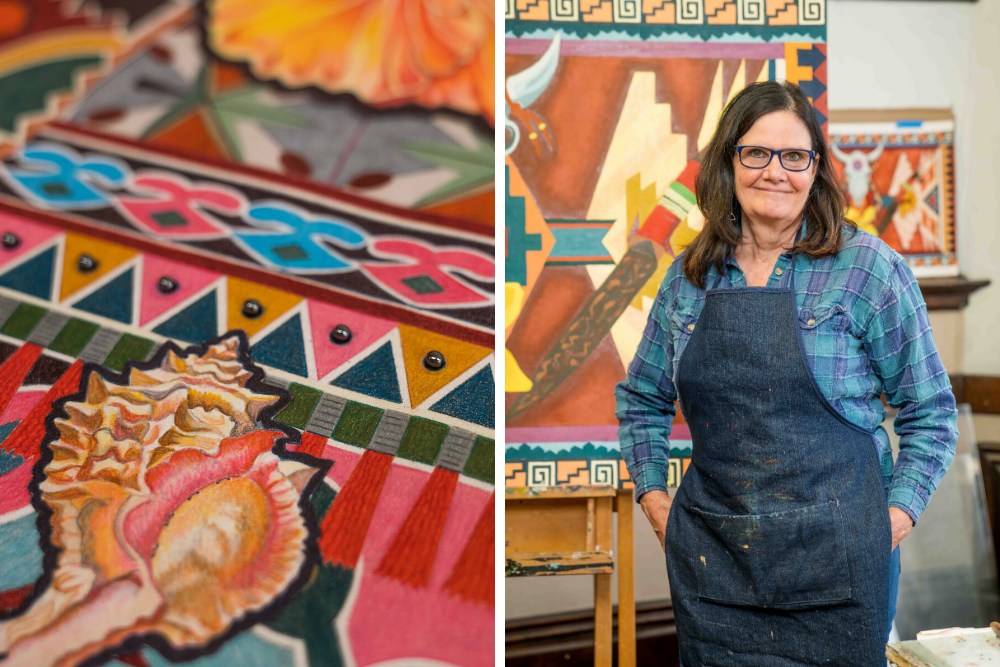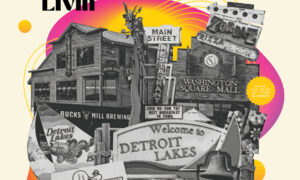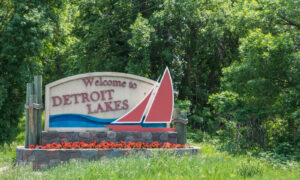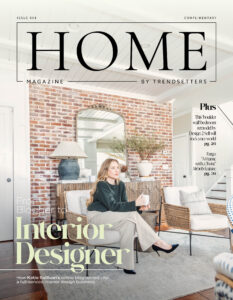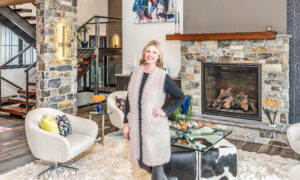Photos by Hillary Ehlen
Warmth is felt as soon as you take a step into Susan Poitras’s studio space in the old Dakota Business College building on 8th Street South. Besides the tricky heating system in the historic building, it’s Poitras’s vibrant work that transports you into a much warmer climate. Inspired by Native American art and color palettes, her work showcases a mix of patterns, natural elements and warms tones. Some imagery often repeated in her work includes animal skulls, flowers, bead-work and Native American rugs, creating mixed-media feeling pieces with depth.
Across her studio are stacks of finished pieces alongside multiple works in progress. Mixed in with the art are parts of the process. There’s a table of neatly organized shells, animal skulls and bones. Plant matter sits near the generously sized windows and photographs of even more plants and flowers lay printed out. Materials and parts of the process, from pigments to tracing paper to canvases to paintbrushes, are organized throughout the ample space. From the excess of supplies, finished products and process pieces, you can tell that this has been her passion for a while now.
Originally from Minneapolis, Poitras began working in the Creative Arts Studio within Clara Barton Elementary School when she moved to Fargo with her husband. Here, she worked on her own pieces, but also worked as a contract teacher, teaching art to children in the region’s schools that did not have art teachers.



After some time of teaching in a contract setting, she craved stability. From there, she moved to where she would spend much of her professional career: working as a florist. For over two decades, Poitras worked at area floral shops, starting at Town and Country Flowers then moving to Cash Wise and then to Hornbacher’s. While she was working full-time as a florist, she had this same studio that she would work in on weekends or during her spare time. Just last year, she retired and has enjoyed getting to dive back into art full-time and work at a more suitable pace and schedule for her liking.
Throughout her childhood and into her professional life, art and creativity have always been with Poitras. From creating pieces to show in town to teaching children to creating works of art with flowers, she has been honing her process for years now.
“I’m very process-oriented. Otherwise, I am lost. I feel like I need a plan. But then I divert from the plan too,” she said. “I think a lot of doing art is creating problems and then solving them. That is kind of a challenge, getting it to all come together in the end.”
Evidence of her dedication to the process can be seen throughout her studio. Her pieces often incorporate geometric shapes and rigid lines, demanding a need for precision and planning. To create flawless repeating patterns, Poitras makes stencils. And to execute symmetry, she often draws half of a piece and reflects it back to create a whole. Another part of her process includes creating smaller-scale versions of the large pieces and gridding them out to transfer them to the large scale. All these steps are parts of her meditative process of creating these highly detailed works of art.



When creating, inspiration comes easily to Poitras. “I don’t have trouble with inspiration. One thing seems to lead to the next, so that is really nice. I was sort of afraid of not knowing where to go. But it seems to be happening pretty easily,” she said. After having worked on her art on and off while she was a full-time florist, she was unsure if she would be able to create on a day-to-day basis without running out of ideas. However, this has not been the case.
For inspiration, she pulls from the Smithsonian Native American archives, textiles, gardens and books. She joked that she has stopped going to the library for inspiration because she thinks she has pulled from every book that interests her there already. In her studio, she has archives of photographs, printed out pages from museum webpages and reference books.
Even with clear inspirations from Native American art and nature, Poitras’s work remains unique and original. “You have to look at what’s been done and take what you like out of what’s been done and put it together in a new way,” she said. With the arsenal of references she keeps on hand, her nods to other cultures are accurate and authentic.
Balancing the natural and the man-made, Poitras has perfected the relationship between the two with her colorful, transportive works. Now that her art is her priority once again, we will look forward to seeing the large-scale still lifes she is so gifted at producing.

Susan Poitras Studio
susanpoitrasart.com
11 8th St S #202
[email protected]

